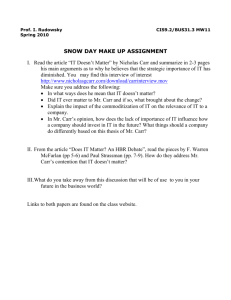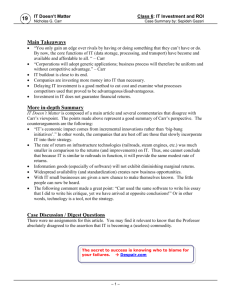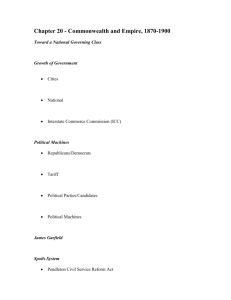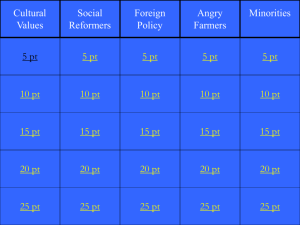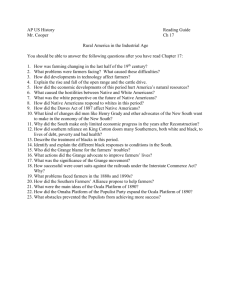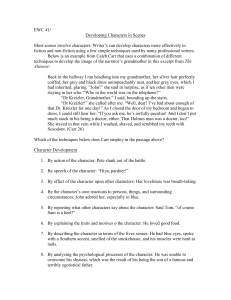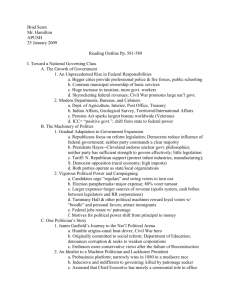A Brief History of the North Carolina Farmers' Alliance
advertisement
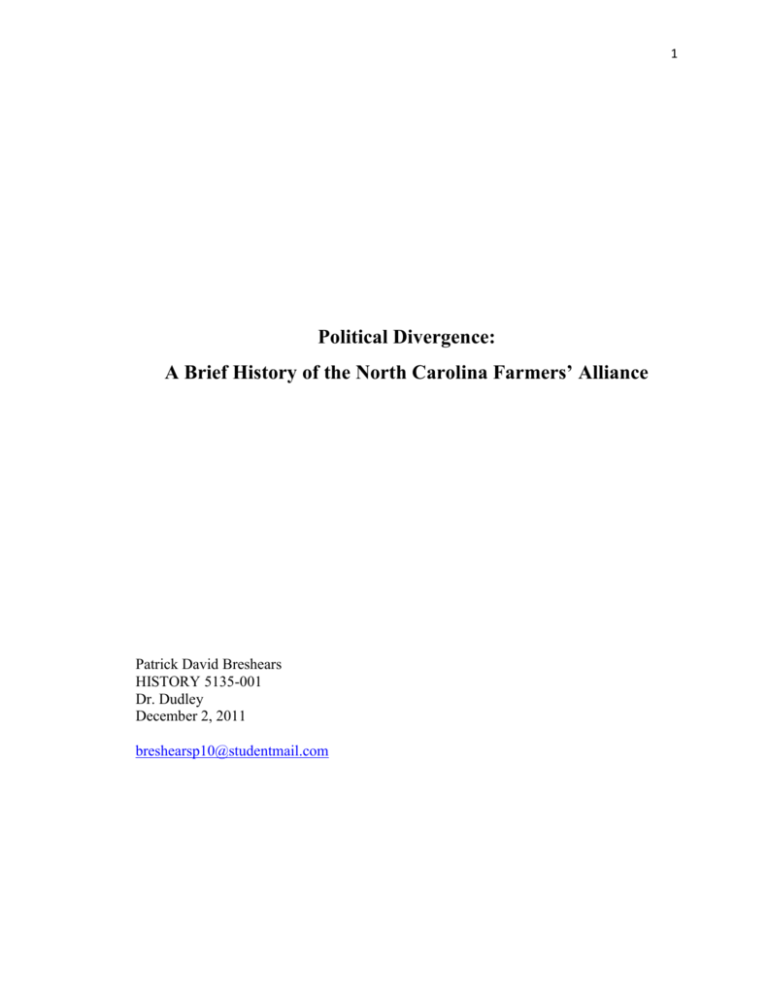
1 Political Divergence: A Brief History of the North Carolina Farmers’ Alliance Patrick David Breshears HISTORY 5135-001 Dr. Dudley December 2, 2011 breshearsp10@studentmail.com 2 The Farmers’ Alliance entered a North Carolina that teemed with agrarian activity. It was not the driver of unity or administer of organization, for local Clubs had already organized before it ever appeared. The Progressive Farmer acted as the early catalyst for organization as it promoted unity and highlighted concerns. However, shortly after the Alliance’s appearance in Wake County, it quickly spread throughout the state and eventually replaced local Clubs and the North Carolina Farmers’ Association. Local Clubs were organized into County Clubs before merging into the State Farmers’ Association. The Clubs organized around issues promoted by the Progressive Farmer, and they gained some initial success. Once established, the Alliance was able to execute some successful economic measures and take over the General Assembly in 1891. Unfortunately, the Alliance could not sustain its economic or political momentum because of weak state leadership. The economic and political priorities became too divergent, for state leaders did not suffer the same economic fragility and could afford to remain loyal Democrats. The increasing radicalization of the rank and file and a key leader, L.L. Polk, gave birth to Populism, which foretold the end of a powerful Farmers’ Alliance in North Carolina. However, the Alliance continued until the Great Depression, a shadow of its former self as it struggled to maintain membership and keep its Business Agency alive. News agencies, the editors, and local farmers filled the pages of the Progressive Farmer with numerous concerns. Farmers considered the mortgage law especially egregious. They considered it a certain cycle of debt that inevitably led to ruin. The Progressive Farmer described it as, “bad for the farmer as the first chill is for the victim 3 in a yellow fever district.”1 Curiously, many farmers and the Progressive Farmer considered it a byproduct of the Homestead Law and motivated by the “entanglements and embarrassments into which he had been unwittingly drawn by treacherous negro labor, and the more treacherous ‘King Cotton.’”2 Despite the obvious resentment towards African Americans’ freedom, cotton was interpreted as a greater threat than black hysteria. Farmers considered it the driving force behind a one crop system that they felt perpetuated the hated mortgage system. Although white supremacy was still important, race politics temporarily lost traction among the agriculture class as depressed conditions elevated economic issues over racial anxiety. The Herrenvolk Mentality that had guided events in North Carolina since its colonial immaturity began to erode, for the average farmer’s frustration with the Democratic Party overtook their immediate fear of black rule. The Progressive Farmer facilitated a campaign to turn back the hands of time to a period of sustenance farming. Numerous articles are dedicated to the promotion of raising necessities instead of one cash crop in order to escape the mortgage system. It advised that: It should be the fixed resolve of every Southern planter, whatever his methods in the past may have been, to raise at least grain and meat enough for his own use, if not for the sale, and thus not be reduced to the necessity of buying these things at a high price, with cotton or tobacco sold at a low price…The thoughtful, sensible, prudent planter will guard against this and put himself beyond the danger of such contingency by raising those necessaries of life which he must have, can raise, and cannot afford to buy, and should not buy if he could not afford it.3 1 “The Mortgage System: Beware of Giving the First Crop Mortgage,” Progressive Farmer, February 17, 1886. 2 “The Homestead Law,” Progressive Farmer, February 24, 1886. 3 “One Crop System,” Progressive Farmer, March 9, 1887. 4 The engagement in a one-crop system and the reliance of mortgages to facilitate it, as well as the angry reactions to that system, is indicative of the need to secure a measurable level of happiness and demonstrable level of dignity. The Land Script Act of 1862 provided federal funding and land grants for the establishment of agricultural and mechanic schools.4 The Progressive Farmer went a step further by advocating for the establishment of agricultural schools in every county.5 It promoted education as a weapon to wield against the other classes, which it perceived as beneficiaries of the farmers’ ignorance. It concluded that the government favored other industries over agriculture and misuse of the Land Script Fund was yet another example of political nepotism. It expressed a sentiment that became a mantra for emerging clubs, “If the Legislature will do as much to teach the producing class how to keep and enjoy the entire proceeds of their honest toil as it does to teach non-producers how to exchange their shadows for the farmers’ substance, how much better would be the condition of all classes.”6 Farmers felt they were the backbone of society and they wanted to use education as a vehicle to secure agriculture, which was continuously affirmed by the pages of the Progressive Farmer. They wanted to recapture the regality of agriculture that seemed such a reality in the Antebellum South, but recast it into a modern context. The Progressive Farmer published an article from an Alabama journal that declared famers, “As a class they are the honor of a country, their interest and progression is the interest of all….”7 However, farmers felt that society had forgotten the importance of the agricultural class, for the author wrote, “I think it is time that other branches be made to 4 “Wasting the Money,” Progressive Farmer, June 23, 1886. “Agricultural Education,” Progressive Farmer, March 3, 1886. 6 Ibid. 7 “Progressive Farmers,” Progressive Farmer, March 24, 1886. 5 5 feel their dependence in some degree.”8 It became their mission to conquer the Babylonians of society and restore themselves to power as the rightful heirs. As an example of legislative antipathy, the misappropriation of the grants fueled resentment towards professionals, especially lawyers since The University of North Carolina had a prominent law school. Farmers felt the money belonged to the agricultural class and should be used for the benefit of farmers. The Progressive Farmer declared, “Let the fund of $125,000 be placed in our Treasury to the credit of the industrial classes, to whom, by the law, it only and rightfully belongs.”9 As with other facets of their dissent, agriculturalists looked outside of the state for evidence of success. The Progressive Farmer juxtaposed Virginia’s and North Carolina’s use of the fund to galvanize the readers, for Virginia successfully used the fund to support two agricultural schools.10 Farmers felt the government was robbing them of their future at a time they perceived education as their only agent of change. The pressure applied to the legislature through the Progressive Farmers’ dissemination of information forced officials and politicians to yield to their demand. By November of 1886, the State Board of Agriculture had purchased land in Raleigh for the new school.11 Progress was slow, but farmers were pleased with their successful lobby of a government that all too often ignored their pleas. By 1888, construction of the school was underway, and the Progressive Farmer found the direction of events, “not only satisfactory, but gratifying.”12 Despite their successful drive to create the college, farmers 8 Ibid. “Industrial Education,” Progressive Farmer, February 17, 1886. 10 Ibid. 11 “Industrial Education,” Progressive Farmer, November 3, 1886. 12 “Our Agricultural and Mechanical College,” Progressive Farmer, January 5, 1888. 9 6 faced increasingly more social, economic, and political hostility as they organized into clubs. By the late nineteenth century, farmers could no longer suffer the depressed values of their crops and the loss of their landed dignity with idle ignorance and isolation. Men of soil and plow looked outside of their profession and found every other industry represented by societies, clubs, and lobbies. Soon after its inception, the Progressive Farmer explained, “There is no business, no industry, that has not its organizations, its co-operatives, its representative bodies, who look after the interests they represent and shape policies to govern them.”13 Spurred by the Progressive Farmer’s alacritous promotion of cooperation and agitative reports on issues it felt paramount, farmers organized local Clubs. Beyond education and debt, the Progressive Farmer also fought against all forms of anti-competitive economic practices. Lambasting the affect of monopolies, the newspaper made the agriculturalists’ stance clear, “We want no highhanded monopolies in this country, for they are a menace to the democratic quality of our institutions, and it is, therefore, full time for the people to grapple with this problem and devise means of relief.”14 Naturally, there were only two strategies to deal with monopolies, trusts, or the mortgage system: affect legislation or organize and employ economic cooperation. Farmers, mostly still loyal, albeit dissatisfied Democrats, initially chose the cooperative route. A Harnett County Club organized in order to take advantage of mutual interest and shared resources. However, they wanted to stay clear of politics, thus they prohibited, “all political speeches, and everything that would tend to stir up 13 14 “Farmers’ Clubs,” Progressive Farmer, March 31, 1886. “Monopolies and Trusts,” Progressive Farmer, February 16, 1888. 7 strife or dividing feelings.”15 Ironically, this early club foreshadowed the tensions that eventually overwhelmed the Farmers’ Alliance in the first few years of the 1890’s. Farmers’ Clubs were quickly organized throughout the state without any state apparatus, and the only central leadership came from the black ink banged across the pages of the Progressive Farmer. It published local Club resolutions and economic activities and promoted the idea of multi-level organization. Clubs immediately pursued economic activities; for example, the Pikeville Club appointed a Business Agent and bought fertilizer, potatoes, and other goods.16 In the September 29, 1886 issue, the paper published a resolution and address by the Forsyth County Farmers’ Club, an influential and active Club. The resolution called for a committee to draft an address that promoted and explained their method of organization. It described the process of establishing Town Clubs, then County Clubs, and finally a State Association.17 This was the model that both the Farmers’ Association and Farmers’ Alliance used in North Carolina. It was a decentralized process that created a binding contract between Clubs. Throughout 1886, the Progressive Farmer promoted the idea of a state organization. As early as May of that year, it appealed to the fervor of local organizations: The work of organizing Farmers’ clubs is progressing in the State, but the work is not yet fairly begun. Wherever the subject is broached and the reasons presented in favor of such organization the result is a Club with fair membership to start with. The organization should not stop at the township Clubs. There should be both township, county, and state organization.18 Together, farmers across the state had grabbed their destiny in order to turn the soil of society over and ensure a greater measure of security. However, as the Clubs turned into 15 “A Farmers’ Club,” Progressive Farmer, March 24, 1886. “Pikeville Farmers’ Club,” Progressive Farmer, February 23 1888. 17 “Address: To the Farmers of North Carolina,” Progressive Farmer, September 29, 1886. 18 “A State Organization,” Progressive Farmer, May 5, 1886. 16 8 the State Farmers’ Association, a new organization entered the state that tended to boil the anxieties of the merchant and professional classes. As calls went out to create a state wide organization, J. B. Barry, an Alliance organizer from Texas, began building Sub-Alliances in Wake County. By June of 1887, a County Alliance was formed from the twelve Sub-Alliances.19 The Farmers’ Alliance used the same decentralized method of organizing as the club movements of 1886. However, the Alliance had a specific procedure of organization that required a certain number of Sub and County Alliances before a State Alliance could be organized. The club movement was informal and only promoted the procedural doctrine as a model for other clubs to imitate. There were no mandated requirements to form County Clubs or a State Organization, but rather a progressive consensus to merge Clubs into a broader Association.20 During the second farmers’ convention of the North Carolina Farmers’ Association, members of Farmers’ Clubs, Granges, and Alliances were present. Elias Carr, president of the Farmers’ Association, initially hoped to combine the action of the different groups into a concerted thrust for farmers’ rights.21 However, the Alliance soon swept the state. It promised greater political and economic action, and had S.B. Alexander, a respected farmer and politician, as a leader. The Progressive Farmer promoted it in the columns of its paper, “The more we see and learn of the Farmers’ Alliance the more we are inclined to speak of its merits and recommend it as the best thing ever offered to the our farmers.”22 Other classes were threatened by its presence, as 19 “Wake County Farmers’ Alliance”, Progressive Farmer, June 23, 1887. “A Farmers’ Convention,” Progressive Farmer, December 1, 1886. 21 “Greensboro Convention,” Progressive Farmer, December 8, 1887. 22 “To the Farmers,” Progressive Farmer, March 20, 1888. 20 9 only farmers were eligible for membership.23 The appearance of the Alliance fermented a growing cultural divergence among farmers and the professional classes. Farmers increasingly disagreed with the professional classes’ political monopoly. The Alliance’s initial promise of political action was kept close to the organization and held as a secret. The political loyalties in North Carolina had only begun to weaken, and any semblance of partisanship or third party sentiment threatened to demobilize the movement. As early as 1886, reports of the Alliance’s activities in other states revealed an inclination towards politics as a strategy to improve and protect farmers. The initial activities centered on economic measures but, over time, the organization shifted its focus to nominating Alliance members to office.24 However, Alexander refuted this notion, claiming that, “The Farmers’ Alliance is not a political organization-Republicans and Democrats belong to it in every state…. It wages no war with any other profession or trade….”25 Despite President Alexander’s remarks, the evolution of the order was exemplified in other states, and North Carolina was no exception. His regard is typical of Alliance leadership in North Carolina. Prevailing wisdom dictated an abatement of radical urges among the members, which only fueled frustration. The leaders did not properly implement the economic measures needed to increase the average farmers’ security, which would have quelled political frustration and thwarted, or at least delayed, entrance into politics. Sub and County alliances diligently pursued numerous avenues of economic progress; they created local purchasing funds, trade houses, home production of goods, 23 Ibid. “The Object of the Farmers’ Alliance,” Progressive Farmer, October 27, 1886. 25 “A Letter From Capt. S. B. Alexander About The Alliance,” Progressive Farmer, December 8, 24 1886. 10 and cooperatives stores.26 The state leadership only provided for a general framework and escalation procedure that delegated responsibilities to the local Sub-Alliance business agents.27 To successfully overcome local merchants, state leaders needed to augment local agents through the concentration of resources and cooperation. The Farmers’ Alliance’s purpose was success through cooperation and unity; but without strong central leadership, local merchants could eventually out maneuver isolated Sub and County Alliances. Farmers were dependants on many complex intangibles, such as weather, and therefore vulnerable to financial exposure and exploitation. If fields did not yield enough or hiccups occurred in local business funds, merchants could easily reassert their dominance. One farmer wrote Elias Carr, then President of North Carolina Farmers’ Alliance, describing the merchants’ attempts to promote dissent within the order to break up their business agency.28 As success turned into failure, the local alliances demanded a state business agency fund, for many felt it was the only way to defeat their enemies. In Radical Protest and Social Structure, Michael Swartz wrote, “its [Business Fund] awaited the failure of the local actions.”29 A successful Business Fund meant that farmers could borrow from it without mortgaging their land and prices could be regulated versus the disparate levels based on negotiations with local merchants. Farmers could also exchange goods with other farmers through a barter system. By establishing the Fund, the Alliance had a better chance of fulfilling their purpose, security through unity. 26 “Alliance Notes” Progressive Farmer, March 5, 1889, June 11, 1889, July 30, 1889. “Meeting of the Business Agents,” Progressive Farmer, October 30, 1888. 28 Wilson to Carr, March 6, 1890. Elias Carr Papers, Collection No 160. East Carolina Manuscript Collection, J.Y. Joyner Library, East Carolina University, Greenville, N.C. 29 Michael Swartz, Radical Protest and Social Structure: The Southern Farmers’ Alliance and Cotton Tenancy, 1880-1890, (New York: Academic Press, 1976), 259. 27 11 The Progressive Farmer facilitated the average member’s agitation for the Fund. In 1888 and 1889, numerous issues contained appeals and ideas from local alliances. The major issue in establishing the Fund was raising the money to support it. A farmer from Windsor, North Carolina wrote: Our State Business Agent stands on rather a too small a foundation to work as he ought, or likely wishes…I will give my plan to add $8,000 to Brother Darden’s foundation and not a man of us put our hands in our pockets for a cent. It is this: Let each Sub-Alliance in the State send up by its delegates to their respective County Alliance Meeting in April $5 for the Business Agency and let each county meeting in April vote $10 for the same end and the $8000 is raised; no one is hurt and the agency helped.30 Not everyone agreed with the farmer from Windsor. Many had sent money to the agent and were ready for operation to begin even if the total sum had not been raised. A farmer in Sampson County lamented that their Alliance had sent in fifty-five dollars, yet nothing had been done. His letter asked for leadership in the matter and called on all brethren to support the fund.31 Despite his appeal, leadership did not readily flow from the President, Executive Committee, or the State Business Agent. Instead of using the funds raised, the State Business Agent, W. A. Darden, refused to initiate the Fund until the full amount was raised.32 Thus, farmers that had earlier paid into the fund (some Alliances sent funds numerous times) did not have access to the agency. Many of these farmers did not have very much money, so the meager amount raised took substantial sacrifice. Some Sub-Alliances borrowed money from wealthier members in order to fulfill their obligations to the Fund.33 Darden was extremely inefficient and contributed to the frustration of those around him. In a letter to Carr, 30 “The Business Agency,” Progressive Farmer, March 12, 1889. “The Business Agency,” Progressive Farmer, September 10, 1889. 32 Alexander to Carr, January 18, 1889, Elias Carr Papers. 33 “A Well Equipped Alliance,” Progressive Farmer, July 9, 1889. 31 12 Darden informed him that he would be unable to attend an important meeting in Raleigh and deferred his responsibilities to Carr.34 Darden finally consented to begin operations in January of 1889, more than a year after the first subscription was made. However, inefficient leadership created confusion when President Carr told Darden to only take orders from County Alliances, while the resolutions adopted at the last meeting instructed the State Agent to fulfill orders from Sub-Alliances.35 State leadership tended to move much more slowly and attempted to restrict the more radical and egalitarian efforts of County and Sub-Alliances. As the drama of the 1880’s drew its curtains, the North Carolina Farmers’ Alliance experienced the same cultural divergence that separated farmers and professionals a few years earlier. The economic reality faced by the average farmer was not the same as that of many of the Alliance leaders, whose ranks were comprised of mainly wealthy planters and prominent Democrats. Once the Fund opened, it was not the plan many had expected. It did not set up a system of low interest credit and did not benefit all members. Sub-Alliance agents sent orders to county agents that then sent the orders to the state agent. Therefore, members had to pay as they went, which negated its potential to relieve farmers from the debt cycle. The Fund to which farmers subscribed was only meant to guarantee transactions, a large departure from the Texas Exchange that had endeared members to the idea.36 Furthermore, members who did not subscribe to the fund were barred from participation. Brother Ivey received inquiries into the eligibility of the Fund when many of the rank and file felt it was wrong to deny any brother benefits. However, Ivey was reluctant to answer them because he did not want to anger either side, as Carr had stated, that to receive 34 Darden to Carr, December 28, 1888, Elias Carr Papers. Darden to Carr, January 21, 1889, Elias Carr Papers. 36 Swartz, Radical Protest and Social Structure, 261. 35 13 benefits, a member had to subscribe.37 Its cash based system and limits on participants denied the members who needed it most and reflected a disinterest among leadership. Many of the state leaders were not overly concerned with the success of the Fund. They had no personal need of it and were concerned that it could damage the order. Earlier in 1888, the Texas Exchange had failed and many worried about the consequences of pursuing it in North Carolina.38 Interest in a successful plan had sparked debates across the state, but state leaders did not expect the same fervor from Darden. Alexander wrote Carr that, “I could not gather from him what he has done-I suppose we take him on faith.”39 Darden felt that the work of the Fund should emanate from the Sub-Alliances.40 The reluctance to promote and establish the Fund, the disinterest displayed at the state level, and its limited scope derailed a potential tool that may have made entrance into politics unnecessary. Instead, the upcoming election overshadowed the anorexic Fund as leadership refocused attention towards politics. The average member was swept away with the idea of usurping the professional classes’ political monopoly. However, state leaders became ambiguous as average members took political notions further than the leaderships’ original intentions. To the average member, entrance into politics did not mean abandonment of the Democratic Party, but rather an agriculturalists’ coup d'état. Alliance men wanted to reform government through the party by electing members as Democrats to the General Assembly. J.L. Freeman wrote Carr expressing this emerging sentiment, “I am a Democrat entirely and I am an Alliance man more, and think our aim and purpose should 37 Ivey to Carr, January 11 1889, Elias Carr Papers. Swartz, Radical Protest and Social Structure, 260. 39 Alexander to Carr, January 18, 1889, Elias Carr Papers. 40 Darden to Carr, December 9, 1888, Elias Carr Papers. 38 14 control the party and not the party us.”41 However, the Alliance’s constitution declared its purpose was, “To labor for the education of the agricultural classes, in the science of economic government, in a strictly non-partisan spirit.”42 State leaders, such as Carr and Alexander, hypocritically denounced partisan promotion within the order while simultaneously promoting reform through the Democratic Party. However, they were not completely comfortable with Alliance tickets, even if they remained Democrats. In September of 1890, S.L. Westall wrote Elias Carr informing him of his County Alliance’s intention to nominate an Alliance ticket. In his response, Carr promoted the ambiguous political stance that became standard, as politics increasingly penetrated the order’s policies. He responded to political concerns: The Alliance has time and again declared they were non political, in a partisan sense of the word, that is, they were not organized for the purpose of naming parties and officers for its members. It is however political in the true and higher application of the term, the sense of government-economics politics and should antagonize monopolies and all other combinations, whether thru the creation of legislation or not…So make the principles of aspirants for office the test, is to keep us on the higher plain.43 Furthermore, he criticized Westall’s County Alliance’s decision to nominate an all Alliance ticket for office. In Carr’s mind, it would hurt white supremacy and the order. He ends the letter by blaming Republicans for all the farmers’ misfortunes.44 State leaders wanted to move the order in a political direction that favored Democrats while portraying nonpartisanship. Carr’s and other leaders’ political ambiguity only served to further tensions and stresses within the order, for the Alliance had spurred a state of intelligent 41 Freeman to Carr, June 30, 1890, Elias Carr Papers. Farmers’ State Alliance of North Carolina, Constitution of the Farmers’ State Alliance of North Carolina, Adopted at Rockingham, N.C, October 4, 1887 (Edwards and Broughton: Raleigh N.C., 1888), 1. 43 Westall to Carr, September 27, 1890, Elias Carr Papers. 44 Ibid. 42 15 agitation among the average farmer. Old political loyalties crumbled slowly as the order engrossed itself in political pursuits. Although the majority of the rank and file supported nominating Alliance tickets, some members agreed with state leaders. However, their concern was honestly based in a desire to remain nonpartisan rather than the dual concern for party and order exhibited by state leaders. The Alliance was not solely comprised of Democrats; there were a number of Republican members. Furthermore, there were a number of Democratic members who resented the Alliance’s entrance into politics. In response to tariff discussions, T. H. Weaver wrote Carr denouncing political subversion, “All the discussion is on free trade side and looks like an effort to align the Alliance with the Democratic Party. Now I am a Democrat but I really don’t think that is right or the best interest of the Alliance.”45 Another member felt the Alliance was not strong enough to elect Alliance tickets and feared it would incur assaults from its enemies.46 Instead of clearly positioning the Alliance into a nonpartisan stance, leaders befuddled members by denouncing partisanship while simultaneously supporting the Democratic Party. Chairman of the Democratic Executive Committee Chambers Smith indicates Carr’s willingness to endorse his party, “You asked me in your letter to ‘indicate where a word’ would be most effective from you.”47 The average member and state leadership, while both working through the Democratic Party, were separating along the political spectrum, as leaders’ stability kept their loyalty solid while the average member’s precarious condition dismantled their allegiance to the traditional party machine. Despite the ruptures caused 45 Weaver to Carr, December 28, 1889, Elias Carr Papers. King to Carr, June 21, 1890, Elias Carr Papers. 47 Smith to Carr, 1890, Elias Carr Papers. 46 16 by the increased politicization of the order, third party sentiment had not cracked the Alliance by 1890. A major point of contention between state leadership and the average member stemmed from Senator Vance’s proposal of the Sub-Treasury Bill and his subsequent refusal to vote for it. He claimed it was unconstitutional in its current form.48 Outrage poured from average members, as they refused to bear anyone that did not openly support their demands. J.L. Horton told Carr that members should nominate candidates who supported Alliance principles and only run themselves if either party failed to nominate such a candidate.49 Although Carr supported the Sub-Treasury Bill, he never wavered in his support for Senator Vance.50 His support for Vance contradicted his earlier emphasis on principles rather than men, for the Sub-Treasury Bill and other Alliance demands trumped prior political allegiances. It also furthered the gulf between leadership and members. In a letter to Carr, J.M. Mewbourne, also a supporter of Vance, stated his concern, “The boys are wrought up to such a high pitch that they will not hear me….I am afraid this will hurt us and our chances in other things.”51 Carr’s support of Vance is indicative of state leaders’ ambiguously hypocritical political position. Vance and Carr’s conversations reveal an implicit motivation to secure the power of the Democratic Party. Vance requested Carr’s influence in using the Alliance to fortify the Democratic Party, and Carr reassured Vance of the Alliance’s intention to maintain the party.52 However, dissention was building among members. L.L. Polk, the national president and owner of 48 Lela Carr Steelman, The North Carolina Farmers’ Alliance: A Political History, 1887-1893 (Greenville: East Carolina University Publications, 1985), 106-108. 49 Horton to Carr, July 10, 1890, Elias Carr Papers. 50 Carr to Robeson, September 29, 1890, Elias Carr Papers. 51 Mewbourne to Carr, August 5, 1890, Elias Carr Papers. 52 Vance to Carr, June 29, 1890; Carr to Vance, July 1, 1890, Elias Carr Papers. 17 the Progressive Farmer, began moving the Alliance in a more radical direction. Members became increasingly frustrated as their efforts to work within the Democratic Party yielded conservatively modest results and Bourbon Democrats either ignored or criticized them.53 In a letter to Carr, Polk defends his papers’ position and accuses the Democratic Party of pushing Vance on the voters and ignoring the requests of the Alliance. He rejects the notion that the Progressive Farmer was promoting a third party, blaming the Bourbon Democrats for the increased agitation.54 Despite his rejection of a third party sentiment, the notion gained traction among many members. Moderate reforms enacted by the Alliance legislation of 1891 and Polk’s propaganda machine amplified the radical urges provoked by Bourbon Democrats.55 Polk’s secretary and author of the editorial “Old Foggy,” D.H. Rittenhouse, was an early proponent of a third party.56 However, most of the leadership did not trust him and felt he was a danger to the order.57 Despite the leaders’ insistence on remaining loyal to the Democratic Party, members viewed both parties as part of a conspiracy to defeat the Alliance.58 By 1890, Polk agreed that money powers controlled both political parties and conspired against the order. Therefore, he implemented a new system of lecturing to keep members indoctrinated.59 He issued a proclamation that introduced his lecture system, called for a stop of internal fighting, and told sub-alliances to rid themselves of disloyal members.60 Polk’s denunciation of the Democratic Party made Carr and Alexander 53 Gore to Carr, July 12 1890, Elias Carr Papers. Polk to Carr, September 9, 1890, Elias Carr Papers. 55 Steelman, The North Carolina Farmers’ Alliance, 145-150. 56 Rittenhouse to Carr, May 5, 1890, Elias Carr Papers. 57 Beddingfield to Carr, July 18, 1890, Elias Carr Papers. 58 Perry to Carr, July 9, 1890, Elias Carr Papers 59 Polk to Carr, June 7, 1890, Elias Carr Papers. 60 “The Alliance Campaign,” The State Chronicle, April 30, 1891. 54 18 nervous, worrying that he was leaning towards a third party.61 Polk’s intensive propaganda program was not the only sign of Alliance disintegration. In May of 1891, the Cincinnati Convention formed the People’s Party. The southern branches of the Alliance did not totally embrace this third party move, and Polk pleaded for cooperation.62 Even after the Cincinnati Convention, Marion Butler did not support a third party. In the Caucasian, his Sampson County based paper, he declared, “We do not need a third party in North Carolina and would regret to see one.”63 However, the average member, in and out of North Carolina, was tired of the major parties. The Progressive Farmer, as it did in the past, acted as a voice for the common member, for farmers turned to its pages. One farmer summed up their support for a third party, “allow me to say there is no way under the sun for us to secure recognition and enforcement of our principles except by separate and distinct political action….”64 Butler, the eventual president of the Populist party, was a shrewd man who read the writing on the wall. Once his county formed a Populist Party, Butler declared his support.65 The Caucasian wrote a small piece about the Sampson County Convention, in which it reversed earlier anti-third party sentiment and declared, “The politician has been silenced. He will have less to say and less to do in the future.”66 Butler was also president of the North Carolina Farmers’ Alliance and, at the annual convention, he declared that unity had been achieved. However, the Alliance was not solely comprised of Populists. Many remained loyal Democrats, especially those 61 Alexander to Carr, March 12, 1891, Elias Carr Papers. Steelman, The North Carolina Farmers’ Alliance, 180 181. 63 The Caucasian, July 2 1891. 64 “Form a Third Party,” The Progressive Farmer, February 23, 1892. 65 Steelman, The North Carolina Farmers’ Alliance, 225- 226. 66 “The Sampson County Convention,” The Caucasian, August 11, 1892. 62 19 in key positions of respect and office.67 Alexander wrote Carr, pleading with him to attend and to impress other loyal Democrats to attend.68 The third party movement lacerated the Alliance, and resentful members were absent from the annual convention, which traditionally drew members from across the state. The old order, comprised and led by loyal Democrats, had given way to the radical impulses of the average members. They could no longer suffer the absolution of other classes and the ambiguity of their leaders. The deteriorating conditions of the 1880’s and the Democrats’ reluctance to placate the farmer combined to move formerly conservative voters towards the radical side of the political spectrum. The comfortable economic position of the leaders of the Alliance kept them stationed in the conservative side of the spectrum as loyal Democrats. Perhaps the most dramatic unfolding of this political pressure gauge was Polk’s decision to end the Progressive Farmers’ stent as the official organ of the Farmers’ Alliance in 1892.69 The Progressive Farmer had initiated, spurred, and kept the farmer movements abreast in North Carolina; thus, its split from the Alliance is symbolic of the Alliance’s finale political divergence. It was a cleavage facilitated by weak leadership, which was partly due to its organizational structure. Leaders’ strong conservative convictions, disinterest in the Business Fund, their constant restraint of the members political activities, and their active promotion of the Democratic Party fueled failure and frustration. In the end, the same weakness made it impossible to stop the flow of third party fervor that emanated from all corners of an Alliance state. 67 Steelman, The North Carolina Farmers’ Alliance, 226. Alexander to Carr, July 12, 1892, Elias Carr Papers. 69 “Another Step Forward,” Progressive Farmer, June 7, 1892. 68 20 Bibliography Primary Sources Caucasian, 1891-1892, North Carolina Collections. Farmers’ Alliance of North Carolina. Constitution of the Farmers’ State Alliance of North Carolina, Adopted at Rockingham, N.C, October 4, 1887. Edwards and Broughton: Raleigh N.C., 1888, North Carolina Collection. Progressive Farmer, 1886-1892, North Carolina Collection. The Elias Carr Papers, Collection No 160. East Carolina Manuscript Collection, J.Y. Joyner Library, East Carolina University, Greenville, N.C. Secondary Sources Schwartz, Michael. Radical Protest and Social Structure: The Southern Farmers’ Alliance and Cotton Tenancy, 1880-1890. New York: Academic Press, 1976. Steelman, Lela Carr. The North Carolina Farmers’ Alliance: A Political History, 18871893. Greenville: East Carolina University Publications, 1985.
